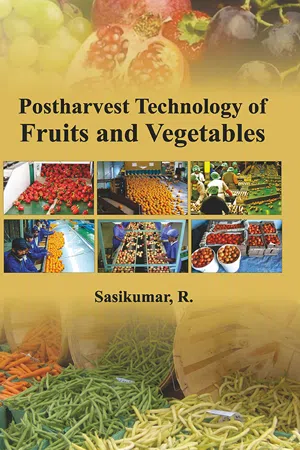
- English
- PDF
- Available on iOS & Android
Postharvest Technology of Fruits and Vegetables
About This Book
"Postharvest Technology of Fruits and Vegetables" is a textbook written in simple brief language and primarily intended as a text book for graduate and post graduate in Postharvest technology, Agri-Business Management & Food Technology, Food Processing Technology, Food Preservation, Quality Control, Home Science, etc., this up-to-date and accessible text gives an in depth information on postharvest technology of fruits and vegetables in an easy-to-read as Indian style. The book covers the syllabus of the basic course on postharvest technology, Fruits and Vegetables Processing Technology, Processing Technology of Fruits and Processing Technology of Vegetables taught in all agricultural universities in India at undergraduate and postgraduate levels. The text book has been divided into 10 chapters and briefs about importance of postharvest technology in India, Maturity and ripening, quality management of fruits and vegetables, storage structures of fruits and vegetables, processing technology of fruits and vegetables, principles of preservation, food laws, recent and advance food packaging, have been included. This well-organized text presents the latest food packaging system, which offers from low cost technology to advance technology in the rural areas and metro cities with various food products. Besides students, the farmers, small entrepreneurs and NGO.s would find the book to be a valuable resource. Distinguishing Features: The book is self-contained and students friendly • Technology in the form of business model • Large number of example, recent processing technology, diagrams and tables illustrate the concepts discussed in the text.
Frequently asked questions
Information
Table of contents
- Cover
- Half Title
- Title
- Copyright
- The Author
- Foreword
- Preface
- Introduction
- 1. Importance and Scope of Postharvest Technology in India
- 2. General Properties of Fruits and Vegetables
- 3. Maturity Indices and Harvesting of Fruits and Vegetables
- 4. Fruits and Vegetables Growth and its Value
- 5. Postharvest Handling Operations
- 6. Principle of Food Preservation
- 7. Processing and Value Addition of Fruits and Vegetables
- 8. Food Additives
- 9. Packaging Materials, Packaging and Transport of Fruits and Vegetables
- 10. Food Laws and Regulations
- References